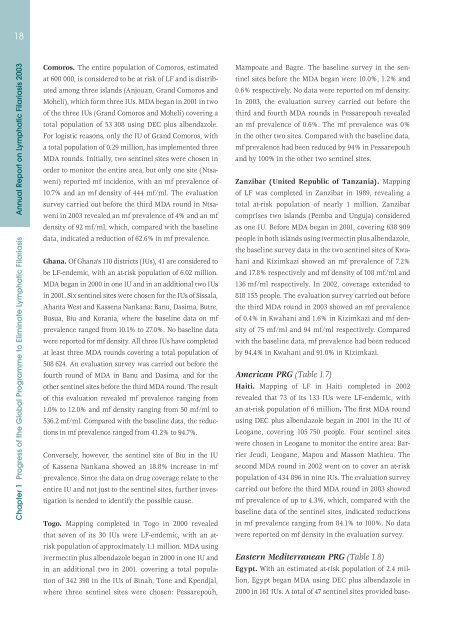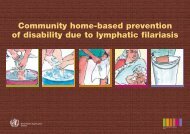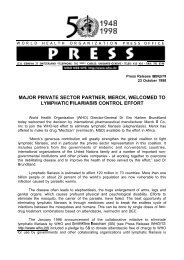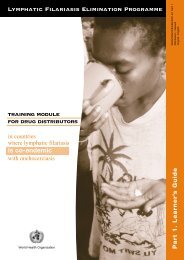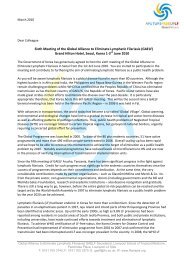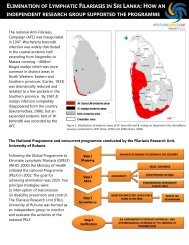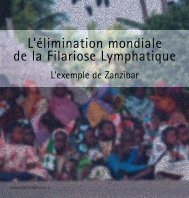Global Programme to Eliminate Lymphatic Filariasis ... - libdoc.who.int
Global Programme to Eliminate Lymphatic Filariasis ... - libdoc.who.int
Global Programme to Eliminate Lymphatic Filariasis ... - libdoc.who.int
Create successful ePaper yourself
Turn your PDF publications into a flip-book with our unique Google optimized e-Paper software.
18Annual Report on <strong>Lymphatic</strong> <strong>Filariasis</strong> 2003Chapter 1 Progress of the <strong>Global</strong> <strong>Programme</strong> <strong>to</strong> <strong>Eliminate</strong> <strong>Lymphatic</strong> <strong>Filariasis</strong>Comoros. The entire population of Comoros, estimatedat 600 000, is considered <strong>to</strong> be at risk of LF and is distributedamong three islands (Anjouan, Grand Comoros andMoheli), which form three IUs. MDA began in 2001 in twoof the three IUs (Grand Comoros and Moheli) covering a<strong>to</strong>tal population of 53 308 using DEC plus albendazole.For logistic reasons, only the IU of Grand Comoros, witha <strong>to</strong>tal population of 0.29 million, has implemented threeMDA rounds. Initially, two sentinel sites were chosen inorder <strong>to</strong> moni<strong>to</strong>r the entire area, but only one site (Ntsaweni)reported mf incidence, with an mf prevalence of10.7% and an mf density of 444 mf/ml. The evaluationsurvey carried out before the third MDA round in Ntsaweniin 2003 revealed an mf prevalence of 4% and an mfdensity of 92 mf/ml, which, compared with the baselinedata, indicated a reduction of 62.6% in mf prevalence.Ghana. Of Ghana’s 110 districts (IUs), 41 are considered <strong>to</strong>be LF-endemic, with an at-risk population of 6.02 million.MDA began in 2000 in one IU and in an additional two IUsin 2001. Six sentinel sites were chosen for the IUs of Sissala,Ahanta West and Kassena Nankana: Banu, Dasima, Butre,Busua, Biu and Korania, where the baseline data on mfprevalence ranged from 10.1% <strong>to</strong> 27.0%. No baseline datawere reported for mf density. All three IUs have completedat least three MDA rounds covering a <strong>to</strong>tal population of508 624. An evaluation survey was carried out before thefourth round of MDA in Banu and Dasima, and for theother sentinel sites before the third MDA round. The resul<strong>to</strong>f this evaluation revealed mf prevalence ranging from1.0% <strong>to</strong> 12.0% and mf density ranging from 50 mf/ml <strong>to</strong>536.2 mf/ml. Compared with the baseline data, the reductionsin mf prevalence ranged from 41.2% <strong>to</strong> 94.7%.Conversely, however, the sentinel site of Biu in the IUof Kassena Nankana showed an 18.8% increase in mfprevalence. Since the data on drug coverage relate <strong>to</strong> theentire IU and not just <strong>to</strong> the sentinel sites, further investigationis needed <strong>to</strong> identify the possible cause.Togo. Mapping completed in Togo in 2000 revealedthat seven of its 30 IUs were LF-endemic, with an atriskpopulation of approximately 1.1 million. MDA usingivermectin plus albendazole began in 2000 in one IU andin an additional two in 2001. covering a <strong>to</strong>tal populationof 342 398 in the IUs of Binah, Tone and Kpendjal,where three sentinel sites were chosen: Pessarepouh,Mampoate and Bagre. The baseline survey in the sentinelsites before the MDA began were 10.0%, 1.2% and0.6% respectively. No data were reported on mf density.In 2003, the evaluation survey carried out before thethird and fourth MDA rounds in Pessarepouh revealedan mf prevalence of 0.6%. The mf prevalence was 0%in the other two sites. Compared with the baseline data,mf prevalence had been reduced by 94% in Pessarepouhand by 100% in the other two sentinel sites.Zanzibar (United Republic of Tanzania). Mappingof LF was completed in Zanzibar in 1989, revealing a<strong>to</strong>tal at-risk population of nearly 1 million. Zanzibarcomprises two islands (Pemba and Unguja) consideredas one IU. Before MDA began in 2001, covering 638 909people in both islands using ivermectin plus albendazole,the baseline survey data in the two sentinel sites of Kwahaniand Kizimkazi showed an mf prevalence of 7.2%and 17.8% respectively and mf density of 108 mf/ml and136 mf/ml respectively. In 2002, coverage extended <strong>to</strong>818 155 people. The evaluation survey carried out beforethe third MDA round in 2003 showed an mf prevalenceof 0.4% in Kwahani and 1.6% in Kizimkazi and mf densityof 75 mf/ml and 94 mf/ml respectively. Comparedwith the baseline data, mf prevalence had been reducedby 94.4% in Kwahani and 91.0% in Kizimkazi.American PRG (Table 1.7)Haiti. Mapping of LF in Haiti completed in 2002revealed that 73 of its 133 IUs were LF-endemic, withan at-risk population of 6 million. The first MDA roundusing DEC plus albendazole began in 2001 in the IU ofLeogane, covering 105 750 people. Four sentinel siteswere chosen in Leogane <strong>to</strong> moni<strong>to</strong>r the entire area: BarrierJeudi, Leogane, Mapou and Masson Mathieu. Thesecond MDA round in 2002 went on <strong>to</strong> cover an at-riskpopulation of 434 896 in nine IUs. The evaluation surveycarried out before the third MDA round in 2003 showedmf prevalence of up <strong>to</strong> 4.3%, which, compared with thebaseline data of the sentinel sites, indicated reductionsin mf prevalence ranging from 84.1% <strong>to</strong> 100%. No datawere reported on mf density in the evaluation survey.Eastern Mediterranean PRG (Table 1.8)Egypt. With an estimated at-risk population of 2.4 million,Egypt began MDA using DEC plus albendazole in2000 in 161 IUs. A <strong>to</strong>tal of 47 sentinel sites provided base-


